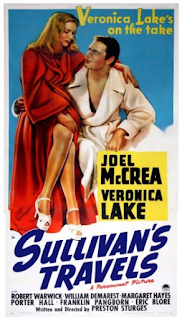 Film director John L. Sullivan (Joel McCrea) wants to create great art. He's tired of making musical comedies like Hey, Hey in the Hayloft and Ants in Your Plants of 1939. He wants to film Oh, Brother Where Art Thou, a searing drama about deprivation and suffering. But the private-school raised Sullivan has never suffered. He decides he must travel America as a hobo to learn about true suffering. The studio heads, however, fear his loss as Sullivan's Travels (1941).
Film director John L. Sullivan (Joel McCrea) wants to create great art. He's tired of making musical comedies like Hey, Hey in the Hayloft and Ants in Your Plants of 1939. He wants to film Oh, Brother Where Art Thou, a searing drama about deprivation and suffering. But the private-school raised Sullivan has never suffered. He decides he must travel America as a hobo to learn about true suffering. The studio heads, however, fear his loss as Sullivan's Travels (1941).We had the opportunity to view this magnificent film at a Preston Sturges retrospective at AFI Silver. I'm sure I've seen it a dozen times, but never in a theatre, so this was a real thrill.
Joel McCrea is perfect as Sullivan. He has just the right amount of sincerity to be convincing, yet you can still be amused at his antics. He is so low-key that you never find Sullivan to be silly - you may shake your head at his ideas, but Mr. McCrea gives him gravitas. His Sullivan believes that the trip is imperative for him to direct his new film. Mr. Sturges wrote the part with Mr. McCrea in mind; they would end up making two more films together (The Great Moment (1944) and The Palm Beach Story (1942).
Veronica Lake (The Girl) was possibly not the first choice - Frances Farmer also tested for the part. (AFI catalog). Unbeknownst to Mr. Sturges, Ms. Lake was pregnant when filming began. Not surprisingly, she was afraid to tell Mr. Sturges - she was already six months along, and beginning to have a bump. Instead, she told Louise Sturges (herself pregnant) who urged her to tell her husband. Ms. Lake did, and Mr. Sturges broke down laughing (Peekaboo: The Story of Veronica Lake by Jeff Lenburg). Thanks to costume designer Edith Head and a number of stunt people, Ms. Lake's pregnancy is not visible. She's adorable in the role, convincing as the down-on-her-luck actress who befriends and eventually loves Sullivan.
There were some problems during the production. Joel McCrea was not fond of Ms. Sullivan - it seems she was trying to seduce him (there are many stories about Ms. Lake's relationships with her leading men), and he was a happily married man. (Christmas in July: The Life and Art of Preston Sturges by Diane Jacobs) So, when he was offered the lead in I Married a Witch (1942), he turned it down rather than work with her again (AFI Catalog). He did finally relent and worked with her in 1947's Ramrod. During the filming of Sullivan's Travels, he saved her life when, after watching a stunt woman jump into Sullivan's pool (in her stead), Ms. Lake decided to join the fun and jump in herself. Her dress wrapped around her head, pulling her under - Mr. McCrea freed her, and carried her out of the water.
One interesting aspect to the film is the way in which Mr. Sturges handles race. When Sullivan arrives at a chain gang, we find men of many races working and eating together. We see Trusty (Jimmy Conlin) walking to the men with a water cup, and all the men, black and white, drink from the cup. Finally, there is a scene in a local church - an African American church - which welcomes the convicts in to see a movie. Nothing is said about race, but these images speak louder than any words could (See this TCM article for more information about the NAACP's comments on the movie).
The other "message" that the film discusses is that of comedy. Sturges felt that his "fellow comedy directors had 'abandoned the fun in favor of the message'" (ReFocus: The Films of Preston Sturges by Jeff Jaeckle). Thus, two films are shown to the audience - at the beginning of Sullivan's Travels we see Sullivan and his colleagues watching a tragedy, after which the feeling in the room is one of sorrow. But when we are with the convicts watching Playful Pluto (1934), there is joy among these normally sad men - they are finally allowed "release and true community" (Christmas in July: The Life and Art of Preston Sturges by Diane Jacobs).
While the New York Times review by Bosley Crowther was favorable (he called it a "beautifully trenchant satire upon "social significance" in pictures"), other reviews were not (ReFocus: The Films of Preston Sturges by Jeff Jaeckle). Regardless, time has shown them the error of their ways. In 2014, Richard Brody in his New Yorker Movie of the week discussed the way in which the movie is actually two films in one, seamlessly moving from comedy to drama and back again.
In 2000, the Coen Brothers were inspired by the film to make O Brother Where Art Thou? (The Cinema of Preston Sturges: A Critical Study by Alessandro Pirolini). Sullivan's Travels was added to the National Film Registry in 1990, and since has appeared on several AFI lists: it was #61 AFI's 100 Years, 100 Films; 10th Anniversary Edition; #25 100 Years, 100 Cheers; and #39 100 Year, 100 Laughs.
Veronica Lake (and Ralph Bellamy appeared on the Lux Radio Theatre version of the film on November 9, 1942. Though that audio program is not available, here's a trailer and a suggestion that you add this remarkable movie to your list:




No comments:
Post a Comment
Thanks for your interest in this blog. Your comments will be moderated to minimize spam to the website. Thanks for understanding.